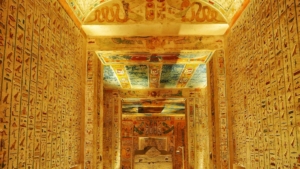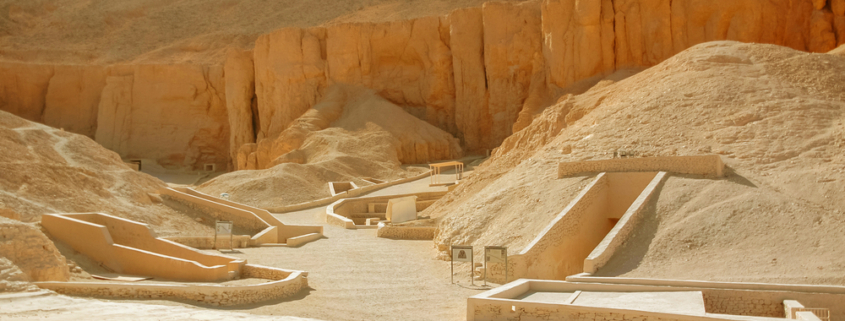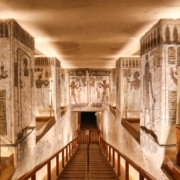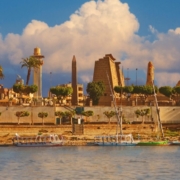Unveiling the Secrets of the Valley of the Kings
The Valley of the Kings, located on the west bank of the Nile River near Luxor in Egypt, is one of the most famous archaeological sites in the world. It served as a royal burial ground for pharaohs and powerful nobles during the New Kingdom period 3500 years ago. Here are some key details and secrets of this fascinating site:
1.
Purpose of the valley of the kings :
The Valley was primarily used to bury pharaohs, along with some high-ranking officials, to protect their bodies and possessions for the afterlife.
2. Location: Nestled in the Theban Hills, it is divided into the East Valley, where most of the royal tombs are located, and the West Valley.
3.
Discovery of the valley of the kings:
The Valley has been a focus of archaeological exploration since the 18th century, with systematic excavations beginning in the early 20th century.
4. Tomb Count: Over 60 tombs have been discovered, each varying in size and complexity, with the most famous being the tomb of Tutankhamun (KV62).
5.
Tutankhamun’s Tomb:
Discovered by Howard Carter in 1922, it was one of the most intact and richly furnished tombs, offering immense insights into ancient Egyptian burial practices.
6.
Construction Techniques of the valley of the kings:
Tombs were carved into the limestone cliffs, featuring corridors, chambers, and elaborate decorations.
7. Hidden Treasures in the valley of the kings: Many tombs were filled with valuable artifacts, though most were looted in antiquity.
8.
Curse of the Pharaohs:
Legends about curses associated with disturbing the tombs have persisted, especially after the discovery of Tutankhamun’s tomb.
9. Wall Paintings: Tomb walls are adorned with intricate paintings and hieroglyphics depicting the pharaohs’ journey to the afterlife and religious texts like the Book of the Dead.
10. Security Measures in the Pharaohs tombs: Ancient Egyptians employed architectural tricks and traps to deter tomb robbers, though many were still breached.

11. KV5: The tomb of the sons of Ramesses II is one of the most extensive, with over 120 chambers.
12. Pharaohs Buried: Notable pharaohs buried here include Seti I, Ramesses II, and Thutmose III.
13. Mummification: The process of preparing the dead for the afterlife included embalming and wrapping, often taking up to 70 days.
14. Recent Discoveries in the vally of the kings: Archaeologists continue to uncover new findings, such as hidden chambers and previously unknown tombs.
15. Valley of the Queens: Nearby, this site was used to bury queens and royal children.
16. Conservation Efforts: Modern initiatives aim to preserve the tombs from threats like flooding, tourism, and environmental damage.
17. Hieratic Graffiti: Workers often left graffiti in the tombs, providing unique insights into their lives and work.
18. Deir el-Medina: The nearby village where the tomb builders lived, offering valuable information about their daily life.
19. Religious Beliefs: Tombs reflect the Egyptians’ beliefs in the afterlife, where the dead would be judged and, if worthy, live forever in paradise.
20. Solar Alignment: Some tombs were aligned with solar events, reflecting the importance of the sun god Ra.

21. Coffin Texts: Inscriptions on coffins provided spells and instructions to aid the deceased in the afterlife.
22. Chamber Layouts: The layout of tombs often mimicked the journey through the underworld, with specific chambers representing different stages.
23. Valley of the Golden Mummies: A nearby site with hundreds of mummies, reflecting continued burial practices into the Roman period but these golden mummies were found in Baharia oasis in the western desert.
24. Economic Impact: The discovery and tourism related to the Valley have significantly impacted the local economy.
25. Howard Carter’s Diary: Provides a detailed account of the discovery and excavation of Tutankhamun’s tomb.
26. Stolen Artifacts: Efforts are ongoing to recover artifacts stolen from the tombs and return them to Egypt.
27. 3D Mapping: Modern technology is used to create detailed maps and models of the tombs for study and preservation.
28. Symbolism: Tomb decorations are rich in symbolism, often depicting gods, goddesses, and mythical creatures.
29. Funerary Objects: Items placed in The tombs included furniture, clothing, food, and shabti figures to serve the deceased in the afterlife.
30. Unfinished Tombs: Some tombs were left unfinished, providing insights into the construction process and the sudden deaths of their intended occupants.
The Valley of the Kings remains a source of mystery and fascination, continually revealing new secrets about ancient Egyptian civilization.
If you would like one day to visit this mysterious place and know more about its secerts , check this link here for more details and offers
Written by ATW Updated July 2024













